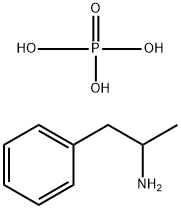| Product Name: | Amphetamine phosphate | | Synonyms: | (±)-alpha-methylphenethylammonium dihydrogen phosphate;(?-?-methylphenethylammonium dihydrogen phosphate | | CAS: | 139-10-6 | | MF: | C9H16NO4P | | MW: | 233.2 | | EINECS: | 205-353-6 | | Product Categories: | | | Mol File: | 139-10-6.mol |  |
| | Amphetamine phosphate Chemical Properties |
| Toxicity | LD50 orl-rat: 175 mg/kg TXAPA9 1,42,59 |
| | Amphetamine phosphate Usage And Synthesis |
| Description | Amphetamine is a potent central nervous system (CNS) stimulant that is used in the treatment of attention deficit hyperactivity disorder (ADHD), narcolepsy, and obesity. Amphetamine was discovered in 1887 and exists as two enantiomers: levoamphetamine and dextroamphetamine. The mode of therapeutic action in ADHD is not known. | | Originator | Raphetamlne,Strasenburgh,US,1950 | | Manufacturing Process | 1 mol of phenyl-nitropropylene, C6H5CH=C(CH3)NO2, is dissolved with a
solvent prepared by mixing one liter of ethanol with one-half liter of acetic
acid and one-half liter of 12 N sulfuric acid. The resultant solution is placed in
the cathode compartment of a divided electrolytic cell containing a metallic
cathode of mercury, copper, or other metal of similar nature. Current is
passed, using a current density of ~0.2 amp/cm2 of cathode surface. The
temperature is kept at about 40°C during the electrolysis which is continued
until at least eight Faradays of electricity have been passed.
When the reduction is completed, the 1-phenyl-2-aminopropane may be
separated from the solution. A convenient way of doing this is by removing the ethanol and ethyl acetate present by evaporation and then making the
residual solution strongly alkaline by addition of caustic alkali. The basic layer
thus formed is separated from the aqueous solution and contains the desired
1-phenyl-2-aminopropane.
135 g (1 mol) of amphetamine (1-phenyl-2-aminopropane) were stirred into
300 cc of acetone in a stainless-steel vessel. To the resultant solution there
were slowly added under constant agitation 115.3 g of 85% phosphoric acid
(containing 1 mol of H3PO4), care being taken to avoid any sudden rise in
temperature or local overheating due to the considerable amount of heat that
is evolved. During the addition of the phosphoric acid a fine, white, flocculent
precipitate appears which becomes more and more dense and abundant, as
the quantity of added acid increases.
When the entire quantity of the phosphoric acid has thus been added,
agitation of the mixture is continued for about a half-hour or more to insure
complete conversion. The precipitate is then allowed to settle, the supernatant
liquid is drawn off, and the residue is filtered. The precipitate thus separated
may, if desired, be washed with acetone and is then dried by evaporation to
constant weight. It forms a fine, white, impalpable powder consisting of pure
monobasic amphetamine phosphate. | | Therapeutic Function | Central stimulant | | Safety Profile | Poison by ingestion andintraperitoneal routes. When heated to decomposition itemits very toxic fumes of POx and NOx. See otheramphetamine entries. |
| | Amphetamine phosphate Preparation Products And Raw materials |
|